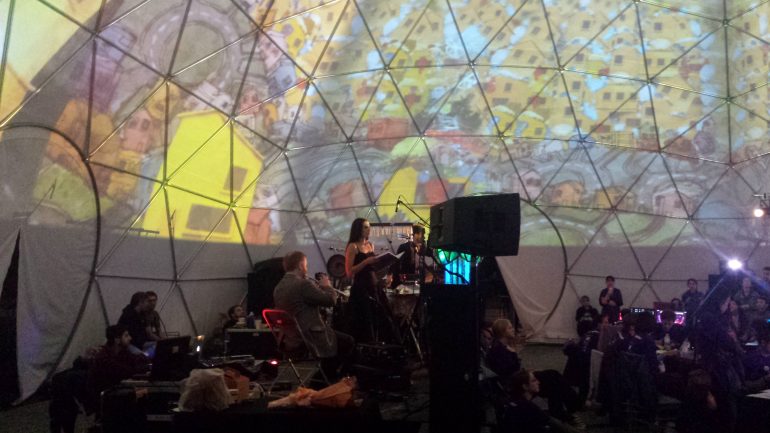Artistic expression took on a whole new meaning this Saturday at Toronto’s Nuit Blanche as one exhibit used the audience’s brainwaves to compose an opera of the future. The art-meets-science-meets-technology exhibit, My Virtual Dream, used sensor-based wearable technology and a computerized replica of the human brain to create an interactive, futuristic and fantastical experience.
My Virtual Dream is a project led by the University of Toronto and Baycrest, the global leader in developing and providing innovations in aging and brain health. Baycrest developed the software which powers the dream, called the Virtual Brain. The team partnered with Toronto-based startup InteraXon to utilize a prototype of their brain-sensing headband Muse.
“Each person in the experience has their own headset on and their generating their own EEG signals that is fed into the Virutal Brain,” explained Dr. Randy McIntosh, Vice-President of Research at Baycrest Health Sciences. “The Virtual brain reads the signals and interprets the activity into animations on the dome. It’s a conversation between the individual participants and their brain, the Virtual Brain and the musicians and it goes back in a cycle to create the dream sequence you see in the dome.”
It was about midnight when myself and twenty others were brought through the main entrance of a sixty-foot dome that sat near Queen’s Park in Toronto. The dome had an eerie quiet about it despite the fact that we were in the midst of one of the largest art festivals in Canada. The glowing Virtual Brain sat close to the stage where the opera singer and her band stood waiting for the action.
We were ushered over to a row of twenty chairs and asked to sit in five groups of four, each facing our own giant monitor. The volunteers asked us to wipe down our foreheads and earlobes. They put a tight fitting plastic headband around each of our heads and attached sensors to our ears. Once we were all setup, the MC told us the games were about to begin.
The first part of the experience, called the Wake Cycle, is aimed at getting us used to focusing our brainwaves. We were walked through a series of cerebral video games which asked us to either concentrate or relax. In all of the games, our brainwaves were visualized on the screen in front of us as balls of fiery light, a different color dedicated to each participant.
If we were successful at either concentrating or relaxing at the cued time then our ball would get more active and brighter. At the end of the exercise our balls would release up into the centre of the dome as fireworks. On screen, we could also see who in the group was the winner from the height of the fireworks. I was pretty crushed as my red fireball continued to struggle amongst the bunch despite the fact it felt I was red in the face from concentrating so hard.
When the games were over it was time to put on a show and enter into the second half of the experience called The Dream Sequence. The MC explained to the group that we would now be using our collective brainwaves to influence visualizations which would be projected on and all around the dome above us. These projections would change based on the groups ability to concentrate or relax together. Live musicians would then interpret these visualizations to add a musical element to the show.
The combination of the strange artistic visions spinning above and the female singers operatic voice interpreting them was quite powerful. But more so was the fact that the composers of this opera were the twenty of us hooked up with Muse prototypes all dreaming this up with our collected brains.
I asked Dr. McIntosh if he felt that this type of experience will become the opera of tomorrow. ‘I hope so. The possibilities are really astounding. When you sit and think about what we are doing tonight and what may happen ten years from now it’s really exciting”.


